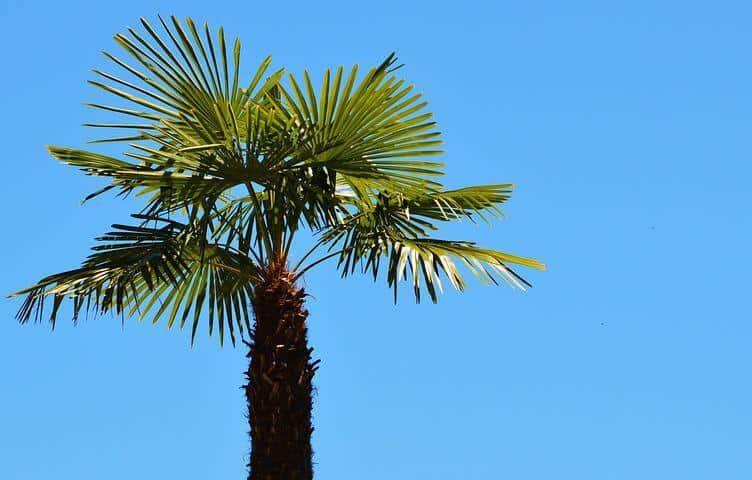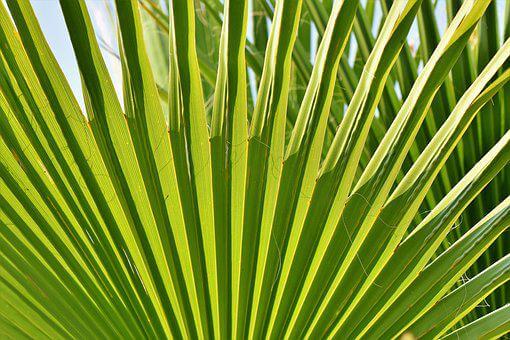Last Updated on January 8, 2023 by a Friendly Gardener
A popular and impressive palm tree more recently cultivated as an indoor houseplant, the Fan Palm is a visually stunning décor addition. If you can’t get away to the tropics, you can create a tropical atmosphere at home or in the office with this striking palm tree. A sunny room or spot anywhere is the ideal location.
Botanically named the Livistona Chinensis and popularly called the Chinese Fan Palm, this is a slow-growing creature featuring a single tree trunk. This palm grows upright and boasts large fronds that are shaped like fans.
The Fan Palm finds its native habitat in Taiwan, China, and Southern Japan. It belongs to the Aceraceae family. Fan Palm fronds can grow six feet wide, so take care to find a corner or location with adequate space when placing this palm. If cultivated outdoors, the Fan Palm will easily grow from thirty to fifty feet high, so if you reside in the proper climate, this is one impressive palm tree. The Fan Palm also boasts an average lifespan in the neighborhood of forty years or more.

Also, consider the European Fan Palm botanically identified as the Chamaerops humilis. This palm is likewise popular for indoor cultivation. It features a number of stems topped by fan-shaped foliage. This plant is perhaps more adapted to indoor cultivation as the size is a bit more contained with stems growing to four feet and palm fronds to approximately two feet in diameter once they have matured.
The Washingtonia Filifera popularly known as the California Fan Palm or Desert Fan Palm is the Continental United States’ largest native palm tree. The “Washington” is primarily cultivated as an outdoor palm. It can grow to sixty feet in height.
Another fan palm to consider is the Hyphaene petersiana or Real Fan Palm, which is a native of Africa and is more commonly known as the Makalani Palm.
Any Fan Palm species merits consideration as these are impressive trees regardless of whether they are cultivated indoors or outdoors. When choosing, make sure you acquire a healthy exemplar. Dried-out palms with brown fronds should be avoided as this will speak to the general health of the plant. Expect a Fan Palm to feature intense green leaves on upright stems. Fan Palms are also a nice houseplant when beginning indoor home gardening.
Fan Palm Care

Growing Medium
When selecting any growing medium for a palm tree, the most important factor will be soil drainage. The soil bed must drain well, and if you choose container cultivation, the pot needs a sufficient number of drainage holes to prevent the appearance of root rot.
Loamy soil is ideal as the soil bed should be kept evenly and constantly moist, especially during your palm tree’s growing season. However, the soil should not be allowed to become soggy. It’s recommended that home gardeners choose a potting mix specifically formulated for palm cultivation. You can mix your own soil if you have peat moss or vermiculite on hand. Add these to the standard potting mix as they serve the purpose of retaining moisture. You can also opt for one part sand mixed with two parts peat moss-based soil.
Light
The Fan Palm, like all palm trees, loves light. Your Fan palm will thrive when exposed to direct sunlight. Four to five hours of daily sunlight is recommended. The remainder of the day can be in partial shade. For indoor cultivation, place the Fan Palm near a south or west-facing window. This type of positioning should adequately satisfy any light needs unless your home or office windows are shaded by the vegetation of others. Younger Fan Palms will need slightly more shade than older, more mature trees.
Water
Your Fan Palm’s soil bed requires moisture retention, but it should not be wet to the point of being soggy. Watering can be increased to ensure sufficient moisture during the spring, summer, and fall seasons.

In the winter, the plant enters dormancy. It will not grow, and the soil bed can dry out. Fan Palms are highly susceptible to overwatering. Only extremely hot prolonged spells require increased watering. As your plant matures and establishes its root system, it will become more accustomed to its environment. Consequently, it will increase its resistance to drought. Should you forget to water, in this case, the Fan palm should be fine all the same.
Humidity
Fan Palms enjoy humidity, so if your plant’s location has dry air, a space humidifier will help. You can choose to mist your palm. Misting will not entirely compensate for a lack of humidity, but it will aid somewhat.
Temperature
Fan Palms like an indoor temperatures measuring from 55° to 60° Fahrenheit during evenings and 70° to 80° F. during the day. Fan Palm trees should not be placed in the vicinity of cooling and heating units or any type of ventilation duct. Table, floor, and even ceiling fans will potentially harm your palm so avoid locations that feature these appliances. Air currents cause temperature fluctuations whereas their natural habitat will provide a warm, humid environment.
Feeding
To feed a Fan palm use a fertilizer specifically formulated for feeding palms. Palm fertilizers have formulas specifically designed with necessary nutrients and particularly extra manganese and potassium. A deficiency in potassium can cause yellow or brown fronds. Begin feeding your Fan Palm at winter’s end or at the start of spring. Continue feeding, following the manufacturer’s indications right through the fall.
Pruning
The vast majority of palms do not require much pruning. This is true for the Chinese Fan palm as well. Only prune if fronds die or have turned entirely brown. Avoid removing dying fronds. Frond should be entirely dead before removal. Partially alive fronds will continue to contribute to tree nourishment. Use sharp garden shears when pruning your palm and cut as close as possible to the palm trunk. Always opt to cut off dead fronds and do not pull them off.
Potting and Repotting

When potting for the first time or repotting a Chinese fan palm indoors, provide a pot that is a bit larger than the palm’s root system or ball. The pot you select needs sufficient drainage holes. Porous clay pots are highly recommended because they aid in wicking moisture away from the tree’s root system.
The need for repotting is rare. The roots of a Fan Palm are exceptionally delicate and should not be stressed by repotting unless absolutely necessary. If the roots appear through drainage holes, or peak from the soil bed surface it’s time for a repotting. Gently remove the palm from its actual container, move it into a new container that is several inches larger, and add in the new soil mix. Water thoroughly before returning the Fan Palm to its preferred spot.
Pests and Problems
The Fan Palm is a relatively hardy and resistant species. It can suffer from scale and spider mites infestations. Serious infestations will cause the fronds to fail. If you do not intervene, your palm can die. Organic Neem oil spray or insecticidal soap are ideal as treatments for pest infestations.
A potassium deficiency is the greatest threat to your Fan Palm. A slow-releasing potassium supplement is a good solution, but watch out for brown frond tips as these indicate excessive fertilization.
Fan Palm Propagation

The propagation of palm trees is done by using seeds. Attempts at division or plant cuttings will generally fail.
A Final Thought

Regardless of the particular FanPalm species you choose, these are stunning plants both indoors and when integrated in landscaping on outside properties. They are not complicated plants to care for. By following a few basic rules, you’ll enjoy a glorious taste of the tropics wherever you reside.

